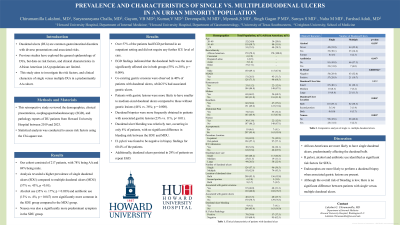Monday Poster Session
Category: Small Intestine
P3181 - Prevalence and Characteristics of Single vs Multiple Duodenal Ulcers in an Urban Minority Population
Monday, October 28, 2024
10:30 AM - 4:00 PM ET
Location: Exhibit Hall E


Lakshmi Chirumamilla, MD
Howard University Hospital
Herndon, VA
Presenting Author(s)
Lakshmi Chirumamilla, MD1, Suryanarayana Challa Reddy, MBBS2, Vijay Bhaskar Reddy Gayam, MD3, Vikash Kumar, MD4, Mrinalini Deverapalli, MBBS2, Swetha Mynedi, MD2, Gagan P. Singh, MD2, Sabtain Saroya, BS2, Nuha Mohammed, BS2, Farshad Aduli, MD2
1Howard University Hospital, Herndon, VA; 2Howard University Hospital, Washington, DC; 3University of Texas Southwestern, Dallas, TX; 4Creighton University School of Medicine, Brooklyn, NY
Introduction: Duodenal ulcers (DUs) are common gastrointestinal disorders with diverse presentations and associated risks. Previous studies have explored the general epidemiology of DUs, but data on risk factors, and clinical characteristics in African American (AA) populations are limited. This study aims to investigate the risk factors, and clinical characters of single versus multiple DUs in a predominantly AA cohort.
Methods: This retrospective study reviewed the demographics, clinical presentations, esophagogastroduodenoscopy (EGD), and pathology reports of DU patients from Howard University Hospital between 2019 and 2023. Statistical analysis was conducted to assess risk factors using the Chi-square test.
Results: Our cohort consisted of 217 patients, with 78% being AA and 69% being male. Analysis revealed a higher prevalence of single duodenal ulcers (SDU) compared to multiple duodenal ulcers (MDU) (57% vs. 43%, p < 0.01). Alcohol use (35% vs. 17%; p = 0.039) and antibiotic use (13% vs. 4%; p = 0.047) were significantly more common in the SDU group compared to the MDU group. Nausea was also a significantly more predominant symptom in the SDU group. Over 57% of the patients had EGD performed in an outpatient setting and did not require any further ICU level of care
EGD findings indicated that the duodenal bulb was the most significantly affected site in both groups (55% vs. 38%; p = 0.004). Co-existing gastric erosions were observed in 40% of patients with duodenal ulcers, while 21% had associated gastric ulcers. Patients with gastric lesions were more likely to have smaller to medium-sized duodenal ulcers compared to those without gastric lesions (44% vs. 36%; p = 0.008). Duodenal biopsies were more frequently obtained in patients with associated gastric lesions (23% vs. 11%, p< 0.01). Duodenal ulcer bleeding was relatively rare, occurring in only 4% of patients, with no significant difference in bleeding risk between the SDU and MDU. H. pylori was found to be negative in biopsy findings for 60.4% of the patients. Additionally, duodenal ulcers persisted in 29% of patients on repeat EGD.
Discussion: African Americans are more likely to have single duodenal ulcers, predominantly affecting the duodenal bulb. Endoscopists are more likely to perform a duodenal biopsy when associated gastric lesions are present. Although the overall risk of bleeding is low, there is no significant difference between patients with single versus multiple duodenal ulcers.
Disclosures:
Lakshmi Chirumamilla, MD1, Suryanarayana Challa Reddy, MBBS2, Vijay Bhaskar Reddy Gayam, MD3, Vikash Kumar, MD4, Mrinalini Deverapalli, MBBS2, Swetha Mynedi, MD2, Gagan P. Singh, MD2, Sabtain Saroya, BS2, Nuha Mohammed, BS2, Farshad Aduli, MD2. P3181 - Prevalence and Characteristics of Single vs Multiple Duodenal Ulcers in an Urban Minority Population, ACG 2024 Annual Scientific Meeting Abstracts. Philadelphia, PA: American College of Gastroenterology.
1Howard University Hospital, Herndon, VA; 2Howard University Hospital, Washington, DC; 3University of Texas Southwestern, Dallas, TX; 4Creighton University School of Medicine, Brooklyn, NY
Introduction: Duodenal ulcers (DUs) are common gastrointestinal disorders with diverse presentations and associated risks. Previous studies have explored the general epidemiology of DUs, but data on risk factors, and clinical characteristics in African American (AA) populations are limited. This study aims to investigate the risk factors, and clinical characters of single versus multiple DUs in a predominantly AA cohort.
Methods: This retrospective study reviewed the demographics, clinical presentations, esophagogastroduodenoscopy (EGD), and pathology reports of DU patients from Howard University Hospital between 2019 and 2023. Statistical analysis was conducted to assess risk factors using the Chi-square test.
Results: Our cohort consisted of 217 patients, with 78% being AA and 69% being male. Analysis revealed a higher prevalence of single duodenal ulcers (SDU) compared to multiple duodenal ulcers (MDU) (57% vs. 43%, p < 0.01). Alcohol use (35% vs. 17%; p = 0.039) and antibiotic use (13% vs. 4%; p = 0.047) were significantly more common in the SDU group compared to the MDU group. Nausea was also a significantly more predominant symptom in the SDU group. Over 57% of the patients had EGD performed in an outpatient setting and did not require any further ICU level of care
EGD findings indicated that the duodenal bulb was the most significantly affected site in both groups (55% vs. 38%; p = 0.004). Co-existing gastric erosions were observed in 40% of patients with duodenal ulcers, while 21% had associated gastric ulcers. Patients with gastric lesions were more likely to have smaller to medium-sized duodenal ulcers compared to those without gastric lesions (44% vs. 36%; p = 0.008). Duodenal biopsies were more frequently obtained in patients with associated gastric lesions (23% vs. 11%, p< 0.01). Duodenal ulcer bleeding was relatively rare, occurring in only 4% of patients, with no significant difference in bleeding risk between the SDU and MDU. H. pylori was found to be negative in biopsy findings for 60.4% of the patients. Additionally, duodenal ulcers persisted in 29% of patients on repeat EGD.
Discussion: African Americans are more likely to have single duodenal ulcers, predominantly affecting the duodenal bulb. Endoscopists are more likely to perform a duodenal biopsy when associated gastric lesions are present. Although the overall risk of bleeding is low, there is no significant difference between patients with single versus multiple duodenal ulcers.
Disclosures:
Lakshmi Chirumamilla indicated no relevant financial relationships.
Suryanarayana Challa Reddy indicated no relevant financial relationships.
Vijay Bhaskar Reddy Gayam indicated no relevant financial relationships.
Vikash Kumar indicated no relevant financial relationships.
Mrinalini Deverapalli indicated no relevant financial relationships.
Swetha Mynedi indicated no relevant financial relationships.
Gagan Singh indicated no relevant financial relationships.
Sabtain Saroya indicated no relevant financial relationships.
Nuha Mohammed indicated no relevant financial relationships.
Farshad Aduli indicated no relevant financial relationships.
Lakshmi Chirumamilla, MD1, Suryanarayana Challa Reddy, MBBS2, Vijay Bhaskar Reddy Gayam, MD3, Vikash Kumar, MD4, Mrinalini Deverapalli, MBBS2, Swetha Mynedi, MD2, Gagan P. Singh, MD2, Sabtain Saroya, BS2, Nuha Mohammed, BS2, Farshad Aduli, MD2. P3181 - Prevalence and Characteristics of Single vs Multiple Duodenal Ulcers in an Urban Minority Population, ACG 2024 Annual Scientific Meeting Abstracts. Philadelphia, PA: American College of Gastroenterology.
